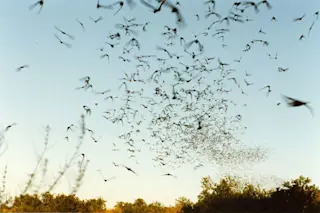These are mother Mexican free-tailed bats emerging from a limestone cave in Texas. They fly as far as 60 miles from the cave, and sometimes a mile or two high, to catch insects. Several million pups (one per mother) are left behind in the cave, where they are packed at densities up to several thousand per square yard. Remarkably, mothers are able to find their pups to nurse them in these dark, noisy caverns. They do so by learning a mental map of the cave geometry, and using a combination of vocal and scent recognition to locate and identify their own pups. As the pups get older they participate more actively in these reunions. Author of Second Nature: The Inner Lives of Animals, Jonathan Balcombe, on his recent book: "We need a complete overhaul in our relationship with (other) animals. The core reason for this is that they are, like us, highly sentient—intelligent, aware, emotional, perceptive, etc. I studied this species of bat for my PhD. Their excellent memories, individual recognition skills, and their capacity to make fine sensory discriminations (spatial, acoustic and olfactory) to identify their babies are a good illustration of the inner lives of animals." Photo by Jonathan Balcombe, courtesy Palgrave Macmillan
Living in Bat City: Millions of Mothers, Millions of Pups
Discover how Mexican free-tailed bats navigate dark caves to find their pups using remarkable sensory skills and cave geometry recognition.
More on Discover
Stay Curious
SubscribeTo The Magazine
Save up to 40% off the cover price when you subscribe to Discover magazine.
Subscribe













